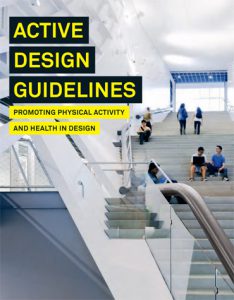By Abbie Watts, Senior Researcher, Center for Active Design
Translating Research to Practice
Over the past few decades, a growing body of public health and social science research has made it clear that there is an inextricable link between the design of where we live, work, and play and human health. In 2010, the City of New York released the Active Design Guidelines, which details many of the ways design can be leveraged to promote health. This evidence-based and multi-disciplinary approach communicates built environment and health research findings in a way that is easily accessible to practitioners. It has now reached over 15,000 professionals across the globe.
The Active Design Guidelines translate the research available at the time of its publication into practical design strategies, with a strong focus on physical activity. As the research has expanded in terms of both design variables and health outcomes, we have come to understand many of the co-benefits of designing for active living. Evolution of the research base warrants innovative directions for encouraging evidence-based implementation.

The Fitwel Certification System
As we have witnessed in the green building movement, certification systems play a critical role in the adoption of best practices for design of the built environment. Therefore, a natural next step for the intersection of design and health was to develop a certification system that would help make the evidence-based strategies that were born out of active design more ubiquitous.
Enter the United States government. Over an intensive five-year process, the Centers for Disease Control and Prevention (CDC) and the General Services Administration (GSA) joined forces to create the Fitwel Certification System. In 2016, the Center for Active Design (CfAD) was selected as the licensed operator of Fitwel and was tasked with expanding Fitwel into the private sector and overseeing third party certification. Fitwel was originally developed for promoting health through the design and operations of workplaces, and in November 2017 CfAD announced a new Fitwel scorecard for multifamily residential properties.
Fitwel awards certification to building and development projects that meet a minimum standard, a Fitwel Star Rating, at one of three levels (One, Two, or Three Stars). Each strategy in Fitwel is weighted based on the evidence related to that strategy and the potential impact on occupant health, meeting one or more of seven health impact categories.
Residential Design and Operations to Support Equity
Supporting social equity for vulnerable populations is one of the seven Fitwel health impact categories and an important outcome for residential settings. Housing affordability and health-promoting housing environments are in high demand, yet many Americans live in communities that are not designed for active living. A survey by the Urban Land Institute found that 38 percent of American respondents lacked convenient outdoor spaces for physical activity, and a quarter felt that traffic makes it unsafe to walk.
In addition to promoting health, multifamily housing that is designed to support the health of residents can reduce turnover, which benefits residents and building owners alike. The Fitwel Certification System successfully fills a much-needed gap, providing a science-based and user-friendly tool for design and development professionals.
Fitwel is also the only qualifying mechanism for Fannie Mae’s Healthy Housing RewardsTM initiative, which provides a 15-basis point loan pricing discount, and reimbursement of certification fees, for borrowers who incorporate health-promoting design and operational features in their newly constructed or rehabilitated multifamily affordable rental properties. This innovative program incentivizes the affordable housing industry to incorporate health-promoting strategies into their projects from the very beginning of the process.
Those involved in the design and development of affordable housing can also use Fitwel as a tool for identifying areas of opportunity, and as a benchmark for demonstrating that a housing development truly is health-promoting. Additionally, many of the strategies included in Fitwel for multifamily residential—such as access to transit, walking trails, and outdoor spaces—can have radiating effects beyond the immediate building or development. In these ways, Fitwel helps pave the way for achieving healthy housing and neighborhoods for all.
Since New York City launched the Active Design Guidelines almost a decade ago, there has been a significant transformation in both research and practice at the intersection of health and design. Fitwel takes the next big step towards making health-promoting design and operations strategies a standard part of design and development practice, which can benefit the health of the American people.
Spread the word! Share this post with your network using this sample tweet: New on the BAYW Blog: From NYC’s Active Design Guidelines to @Fitwel, @active_design describes how healthy design strategies is transforming the environments where we live, work and play! https://bit.ly/2JDH0Ub